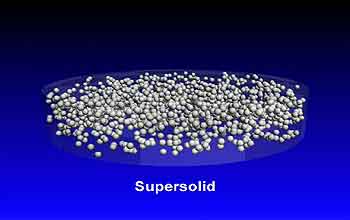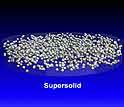News Release 04-005
A Possible New Form of "Supersolid" Matter
Frozen helium-4 behaves like a combination of solid and superfluid
January 14, 2004
This material is available primarily for archival purposes. Telephone numbers or other contact information may be out of date; please see current contact information at media contacts.
Researchers at the Pennsylvania State University are announcing the possible discovery of an entirely new phase of matter: an ultra-cold, "supersolid" form of helium-4.
Writing in the 15 January 2004 issue of the journal Nature, Penn State physicist Moses H. W. Chan and his graduate student, Eun-Seong Kim, explain that their material is a solid in the sense that all its helium-4 atoms are frozen into a rigid crystal lattice, much like the atoms and molecules in a normal solid such as ice. The difference is that "frozen," in this case, doesn't mean "stationary." Because helium-4 lattice is so very cold, less than one tenth of a degree above absolute zero, the laws of quantum uncertainty take over. In effect, the helium atoms start to behave as if they were both solid and fluid-at the same time. Under the right circumstances, in fact, some fraction of the helium atoms can begin to move through the lattice like a substance known as a "superfluid": a liquid that moves with no friction whatsoever. Thus the name "supersolid."
Chan and Kim's work, which was funded by the National Science Foundation (NSF), is described in a Penn State press release posted on the EurekAlert site. That site has an embargo of 1 pm Eastern time, 14 January 2004. After that time, the release will also be available at http://www.science.psu.edu/alert/Chan1-2004.htm.
In addition, NSF has prepared an animation that illustrates the basics of Chan and Kim's experimental setup, and the supersolid behavior they believe they have detected.
-NSF-
-
View Video
The heart of Chan and Kim's experimental apparatus is a disk filled with solid helium-4.
Credit and Larger Version
Media Contacts
M. Mitchell Waldrop, NSF, (703) 292-7752, email: mwaldrop@nsf.gov
Program Contacts
Hollis Wickman, NSF, (703) 292-4929, email: hwickman@nsf.gov
Principal Investigators
Moses H.W. Chan, Pennsylvania State University, (814) 863-2622, email: Mhc2@psu.edu
The U.S. National Science Foundation propels the nation forward by advancing fundamental research in all fields of science and engineering. NSF supports research and people by providing facilities, instruments and funding to support their ingenuity and sustain the U.S. as a global leader in research and innovation. With a fiscal year 2023 budget of $9.5 billion, NSF funds reach all 50 states through grants to nearly 2,000 colleges, universities and institutions. Each year, NSF receives more than 40,000 competitive proposals and makes about 11,000 new awards. Those awards include support for cooperative research with industry, Arctic and Antarctic research and operations, and U.S. participation in international scientific efforts.
Connect with us online
NSF website: nsf.gov
NSF News: nsf.gov/news
For News Media: nsf.gov/news/newsroom
Statistics: nsf.gov/statistics/
Awards database: nsf.gov/awardsearch/
Follow us on social
Twitter: twitter.com/NSF
Facebook: facebook.com/US.NSF
Instagram: instagram.com/nsfgov




